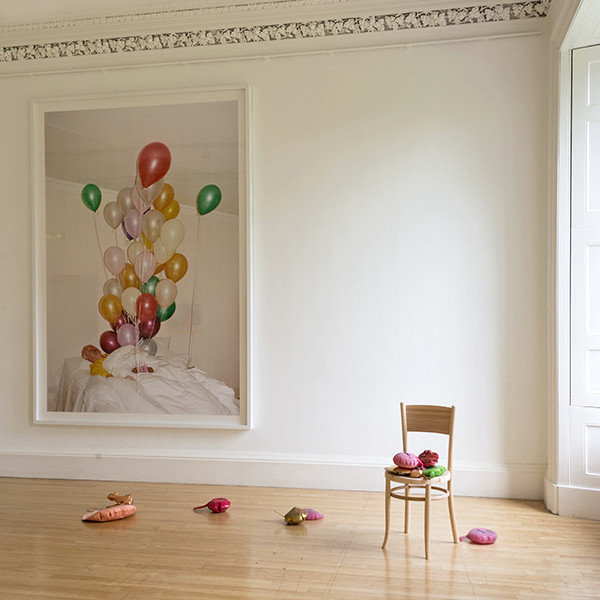On Tuesday, Royal Botanic Garden Edinburgh (RBGE) announced that they were closing Inverleith House, one of Scotland’s leading art galleries, due to financial challenges. There’s a cruel irony, or maybe a last-ditch flame of hope, to the title of the current show at Inverleith House, ‘I still believe in miracles’, which celebrates 30 years of the gallery and features works by a diverse roster of artists who have previously exhibited there, including Jim Lambie, Isa Genzken, Lucy McKenzie and Lawrence Weiner. Maybe a miracle will still happen – the campaign group 38 degrees has launched an online petition to save the institution – but Inverleith House’s future looks bleak. ‘I still believe in miracles’ (which closes this weekend) is likely to be the gallery’s final show.
Juergen Teller, Cerith, Suffolk, 2011 (Courtesy Studio Juergen Teller); Dan Colen, Blowin in the wind, 2013 (Courtesy of the artist, Gagosian Gallery). Installation view, ‘I still believe in miracles’, Inverleith House, Royal Botanic Garden Edinburgh

The decision to shut Inverleith House is sudden, shocking and sad. For many years it has pulled off that enviable combination: exhibitions of consistently high quality that also surprise and challenge. The space itself holds an important place in Scotland’s cultural history. Situated in a beautiful location at the heart of Edinburgh’s Royal Botanic Gardens, the elegant Georgian building was constructed in 1773 and became part of the RBGE in 1820. From 1960 to 1984 it housed the Scottish National Gallery of Modern Art, before that institution expanded into its current site in west Edinburgh.
Since 1986, Inverleith House has played an important and distinctive role in Edinburgh’s visual arts scene. Under the directorship of Paul Nesbitt, it has mounted aesthetically engaging and intellectually stimulating displays of artists with connections to Scotland, as well as international big-hitters. Glasgow School of Art graduate Alex Dordoy’s ‘Persistancebeatsresistance’ of 2014 springs to mind, while the Genzken show of the same year was a personal highlight for its uncompromising approach and range of illuminating works. Inverleith House’s section of the British Art Show 8 in 2016, although quieter than the Talbot Rice installation and smaller than that at the Gallery of Modern Art, stole the show with its screening of Patrick Staff’s film The Foundation (2015), and its placement of sculptures in the surrounding greenhouses. A lively series of events have accompanied the exhibitions – from a public discussion of Staff’s work, to poetry readings inspired by John Chamberlain’s sculptures.
Marc Camille Chaimowicz, Series One, Drawing No. 7 (London, August), 1995, Series One, Drawing No. 9 (Agey, August 24th), 1995, Series One, Drawing No. 10 (Agey), 1995, Series Three, Drawing No. 1, Oxford, November, 1997 (Courtesy the artist, Cabinet Gallery, London). Installation view, ‘I still believe in miracles’, Inverleith House, Royal Botanic Garden Edinburgh

As noted in the press coverage, RGBE’s announcement comes during the same week that Creative Scotland published their Visual Arts Sector Review, which charts the range of financial pressures on institutions and individual practitioners in Scotland. The report notes the importance of increasingly limited public money, together with the vast amount of unpaid and low-paid work that often underpins institutions, and which many artists themselves undertake. For all the successes that Scottish arts organisations can claim, the findings highlight the sector’s precarious nature. Inverleith House reads like a case study in this respect. Although it has received £1.5m since 1994 from Creative Scotland, it was unsuccessful in a recent application to the body for regular funding. Rather than seeking out other options to support the gallery, RGBE has opted for closure.
Coming hard on the heels of the news that the English exam board AQA will discontinue A-Level art history from 2018, Inverleith House provides another example, as if more were needed, of just how quickly sustained economic, intellectual and emotional investment in the arts can be undone overnight.
Lead image: used under Creative Commons licence (CC BY-SA 2.0)



